Click on images to enlarge
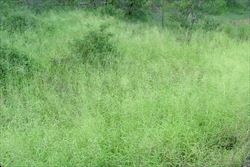
large infestation (Photo: Sheldon Navie)

infestation (Photo: Sheldon Navie)
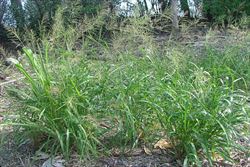
habit (Photo: Sheldon Navie)
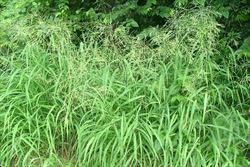
habit (Photo: Sheldon Navie)

stems, leaves and young seed-heads (Photo: Sheldon Navie)
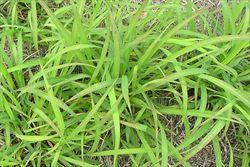
the leaves of this species are often pale green in colour, especially when growing in a sunny position (Photo: Sheldon Navie)

much-branched seed-head (Photo: Sheldon Navie)
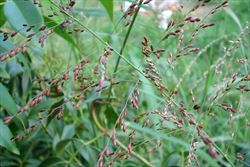
purplish-coloured flower spikelets (Photo: Sheldon Navie)

an old seed-head, that has already shed nearly all of its seeds (Photo: Sheldon Navie)
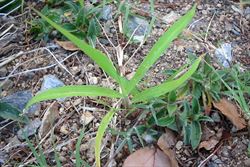
young plant (Photo: Sheldon Navie)

comparison of the relative size of green panic (Megathyrsus maximus var. pubiglumis), on the left, and Guinea grass (Megathyrsus maximus var. maximus), on the right (Photo: Sheldon Navie)
Scientific Name
Megathyrsus maximus (Jacq.) B.K. Simon & S.W.L. Jacobs var. pubiglumis (K. Schum.) B.K. Simon & S.W.L. Jacobs
Synonyms
Panicum maximum Jacq. var. trichoglume Eyles ex Robyns
Urochloa maxima (Jacq.) R.D. Webster var. trichoglume (Robyns) R.D. Webster
Family
Gramineae (South Australia)
Poaceae (Queensland, New South Wales, the ACT, Victoria, Tasmania, Western Australia and the Northern Territory)
Common Names
green panic, green panic grass, green panicgrass
Origin
Native to Africa.
Cultivation
Green panic (Megathyrsus maximus var. pubiglumis) has been widely cultivated as a pasture grass in the warmer regions of Australia.
Naturalised Distribution
Widely naturalised in eastern Australia (i.e. in large parts of Queensland and in many parts of northern and eastern New South Wales). Also occasionally naturalised in south-eastern South Australia and possibly naturalised in the Northern Territory.
Habitat
A very common and widespread weed of crops, orchards, vineyards, disturbed sites, roadsides, railways, footpaths, parks and gardens, bushland and riparian vegetation in the tropical, sub-tropical, warmer temperate and semi-arid regions of Australia.
Habit
A long-lived (i.e. perennial) grass with short underground stems (i.e. rhizomes) forming tufted clumps and aboveground stems that are usually upright (i.e. erect) in nature. Green panic (Megathyrsus maximus var. pubiglumis ) usually grows 0.5-1.5 m tall.
Distinguishing Features
- a large, clumping, long-lived grass usually growing 0.5-1.5 m tall.
- its long and narrow leaves are large (15-40 cm long and 5-20 mm wide).
- its much-branched seed-heads bear large numbers of small flower spikelets.
- the lowermost branches of its seed-heads are arranged in a cluster.
- its slightly hairy flower spikelets are green or purplish in colour and are shed from the seed-head entire when mature.
Stems and Leaves
The stems may be branched and vary from being hairless (i.e. glabrous) to quite hairy (i.e. pilose).
The leaves consist of a sheath, which encloses the stem, and a spreading leaf blade. These long and narrow leaves are large (15-40 cm long and 5-20 mm wide) with entire margins and pointed tips (i.e. acuminate apices). Like the stems, they can vary from being hairless (i.e. glabrous) to being quite hairy (i.e. pilose), but they are most commonly sparsely hairy (i.e. puberulent). The leaf blades are usually held flat and their margins are rough to touch (i.e. scabrous). Where the leaf sheath meets the leaf blade there is a small membranous structure topped with hairs (i.e. ciliate membrane).
Flowers and Fruit
The loosely branched seed-heads (i.e. open panicles) are 10-40 cm long. Their lowest branches are arranged in a cluster (i.e. whorl), while the branches further up the seed-head are variously arranged. The flower spikelets are small (3-4.5 mm long) and oval (i.e. elliptic) or oblong in shape. They are generally green in colour, but occasionally may be purplish or reddish in colour. These flower spikelets are sparsely hairy (i.e. puberulent) and have only one fertile floret. They are shed from the seed-head entire when mature.
Reproduction and Dispersal
This species reproduces mainly by seed, which are dispersed by animals, wind, water, vehicles, machinery. Seeds may also be spread in contaminated soil and agricultural produce (e.g. fodder or grain).
Environmental Impact
Green panic (Megathyrsus maximus var. pubiglumis) is regarded as an important environmental weed in Queensland, where it is actively managed by community groups, and as a minor environmental weed in northern New South Wales.
Other Impacts
This species is also a widespread weed of crops in northern Australia (e.g. plantation crops, vegetables, sown pastures, cotton, legumes, summer crops and brassica crops).
Legislation
Not declared or considered noxious by any state government authorities.
Similar Species
Green panic (Megathyrsus maximus var. pubiglumis) and Guinea grass (Megathyrsus maximus var. maximus) can be distinguished from each other by the following differences:
- green panic (Megathyrsus maximus var. pubiglumis) is a moderately-sized plant (usually about 1.5 m tall) with large leaves and seed-heads. Its leaves are usually paler green in colour and its flower spikelets are usually finely hairy.
- Guinea grass (Megathyrsus maximus var. maximus) is a large and robust plant (1.8-3 m tall) with very large leaves and seed-heads. Its leaves are usually dark green in colour and its flower spikelets are hairless.

